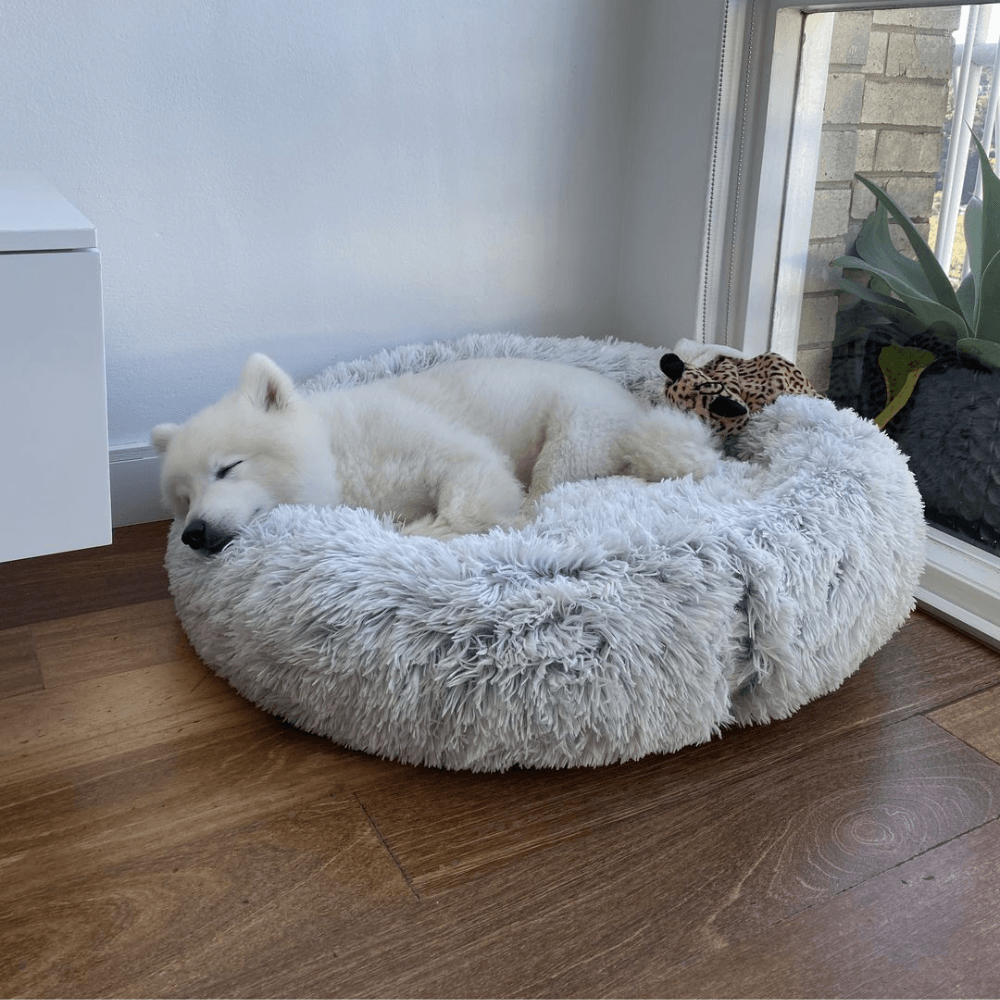
Calming Dog Beds
7 products
Showing 25 - 7 of 7 products
Calming Dog Bed Guide
Believe it or not, pets get anxious just like their owners. One in four dogs experience anxiety daily. We all lead busy lives and can’t be home every minute of every day to support them – as much as we would love to! Calming pet beds are actually backed by science (so you don’t have to take it from us!).
Here’s how it works: when puppies come into the world they aren’t kept safe and warm through their mother’s touch as they snuggle in with their siblings. As they grow, they never lose the comfort that comes from this sense of touch. This is where the calming pet bed comes in. They replicate this feeling they remember from being a puppy, huddled close to their brothers and sisters. But not all calming beds are created equal.
Calming dog beds need to have some key features:
- Soft, short, fluffy faux fur that mimics the feeling of sleeping next to their mother and siblings.
- Raised rim that offer a sense of security, like they are laying up against their mother for comfort.
- A premium inner filling that they can sink into.
- Machine washable as sometimes your dog will get dirty!
Let’s face it, sometimes we all need a big, warm hug at night. Your canine friend might feel the same. This calming pet bed fills that void for them, letting them sink into the warmth and comfort it provides, giving them as sense of security as they settle in for a nap. If they ever feel worried, unsure or uncertain, their calming dog beds act as a safe place they can go to feel at home.
Do calming dog beds work?
The short answer: yes. But don’t take our word for it. Dogs are our babies, there’s no two ways about it. We want them to feel as comfortable and secure as possible. Pet beds do just that. But not all calming beds are created equal, so it’s important you recognise exactly what they do.
Reduce Stress
We can’t be there for our pets all day and night. When you are out, the slightest noise can send your pet into a panic. A calming pet bed offers them a safe place to turn to in these times. They provide your dog a sense of security. The walls of the dog bed help the dog feel safe. Born into litters, puppies are gifted the sense of touch from the moment they are born. They are used to huddling up, surrounded by their siblings and mum, feeling safe and secure. Calming dog beds aims to replicate this safe place for them.
Orthopedic support
The raised walls of the pet bed also provide support for the neck and spine whilst they sleep. This can help reduce the dogs feeling of muscular and skeletal discomfort. This pain can also lead to anxiety in your pet, so it’s important to alleviate it as much as possible. Calming dog beds offer these benefits and more.
So yes, calming dog beds do work, as long as you find the right one! You need a calming bed that replicates that feeling of safety and comfort your pet experienced as a puppy. Nice, soft fur, raised edges to lean into, and soft padding for them to settle into.
What are signs of anxiety in dogs?
Anxiety in dogs is very common, with one in four dogs suffering from it. That’s why it’s important to understand the signs of anxiety so you can recognise them in your own pet. There are lots of clues that your dog is feeling anxious. These include:
- Avoiding eye contact
- Tail between their legs
- Destructive behaviour
- Barking and whining, panting, pacing and trembling
These behaviours are completely normal when your dog is in an uncomfortable position. It’s when they are exhibiting multiple signs over a period of time that it becomes a problem. No one likes to see their best friend in this kind of distress. If the symptoms are getting worse then it would probably be a good idea to call a pet behaviour expert.
What causes a dog to be anxious?
Dogs can suffer from anxiety for a number of different reasons. Sometimes it is obvious, other times they leave you guessing. Here are some of the common reasons for anxiety in dogs:
Separation Anxiety
This is the most common cause of anxiety in dogs and it’s hard to treat. Dogs are naturally sociable animals and love being around you. You can try and improve their separation anxiety by taking them for a walk before you leave the house and not making a big fuss of them when you leave or return.
Illness
If your dog has suddenly started demonstrating more anxious behaviour then there’s a chance that they have some type of illness or disease. If you notice a behaviour change like this please make sure that you take your dog straight to the vet. It’s best to consult a professional so that they can rule out your buddy being sick.
Rescue/Shelter Anxiety
If your pet has spent a period of time in a shelter, then they may have memories of being abandoned there, or a traumatic event may have occurred beforehand that led them there. These dogs can be anxious because of these experiences. They may fear being abandoned again.
General Anxiety
Sometimes your dog is anxious, just because they are. There is no one reasons for the onset of their anxiety. It could have been a build-up of a number of different things, or they could simply be prone to it.
Some dog breeds are actually more prone to it:
- German Shepherd
- Labrador Retriever
- Border Collie
- Shorthair Pointer
- Cocker Spaniel
- King Charles Spaniel
- Greyhounds
How do you calm an anxious dog?
Recognising the anxiety is just the first step. Then you need to work out ways to help them with it. Here are some different solutions to your dog’s anxiety.
Throw toys at it – literally!
Dogs get bored easily. This boredom can full their anxiety as they are left alone to their thoughts. Dogs actually have a preference for newness. Psychologist refer to this tendency as ‘neophilia’. According Anne Pullen, the co-author of a study that looking into this, toys should be “soft, easily manipulable toys that can be chewed easily and/or make noise. Dogs quickly lose interest in toys with hard unyielding surfaces, and those that don’t make a noise when manipulated”.
Exercise regularly
As a dog owner, you should already know the importance of regular exercise. But it’s just as important to make sure you mix up the route you take. As we mentioned above, dogs love newness. A new route provides them with new smells and new scenery. It’s a great adventure!
Train them
So much time and effort goes into training a new puppy, but then this fizzles out as they get older. Training is actually the perfect workout for your dog’s brain, providing them with much-needed mental stimulation that helps with their anxiety. Think of whole new tricks! Stay, heel, run, fetch and so on. It’s time to have some fun!
Give him a playmate
You might not be planning a second dog in your household, but if you’re open to the idea, it can help immensely. Having a buddy with them will help ease their anxiety when you have to leave the house. Dogs love to socialise, and the company of other dogs has shown to enhance their feelings of security and companionship. Plus, it also helps ease your guilt when you have to go out for the day.
Give them a calming bed
Of course, calming dog beds are another excellent tool to help with that anxiety. It provides them with that much-needed sense of security and becomes their safe place when you are out and about day or night.
